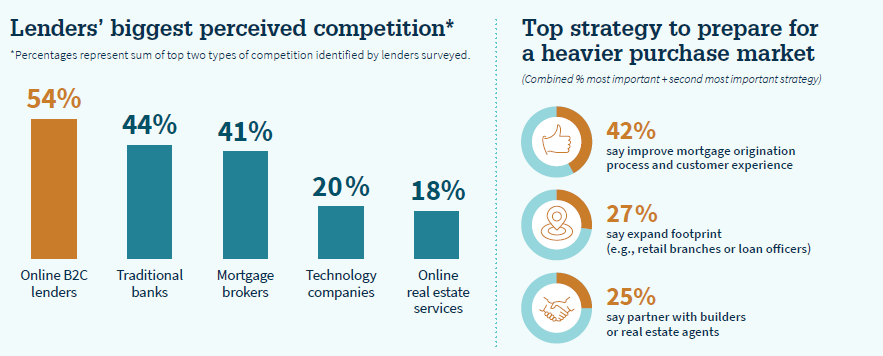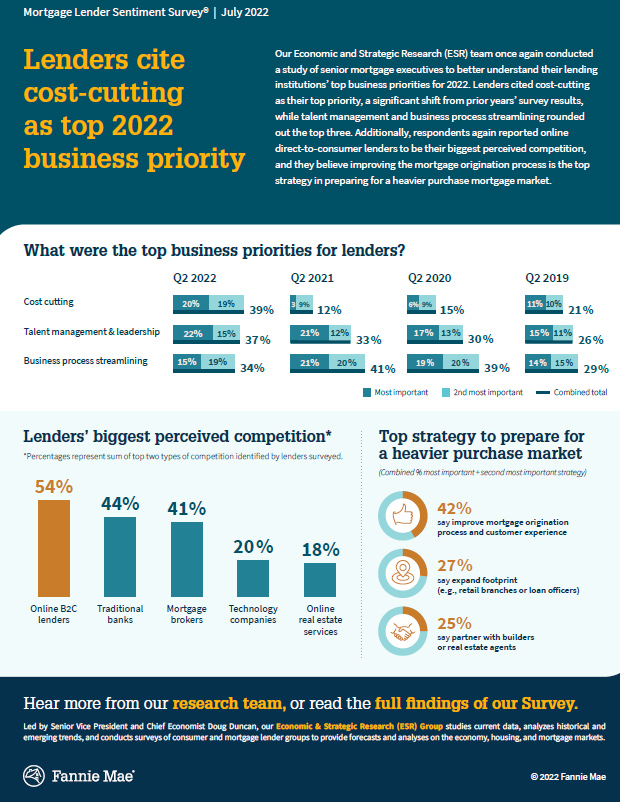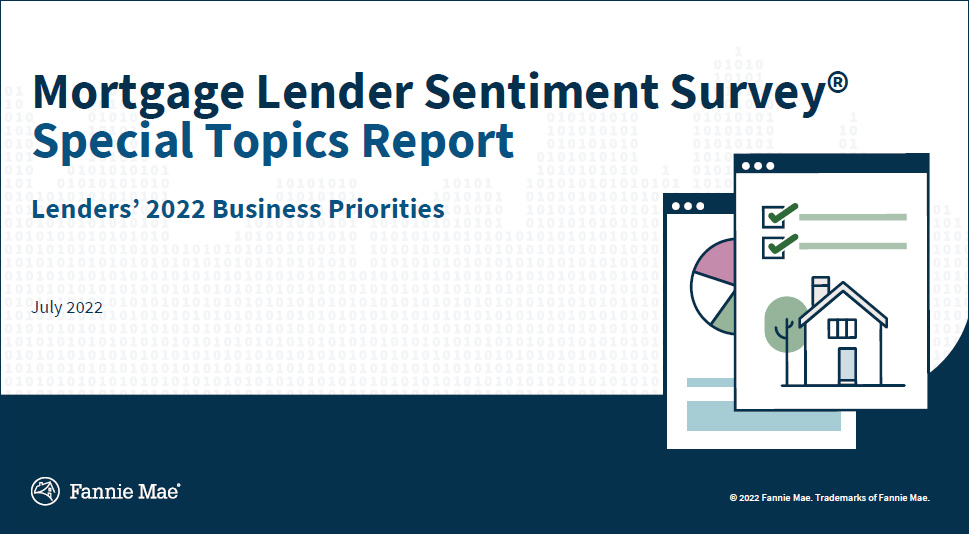Lenders Cite Cost-Cutting as Top 2022 Business Priority
Mortgage lenders' business priorities shifted significantly this past quarter compared to prior years, according to Fannie Mae's Mortgage Lender Sentiment Survey® (MLSS), with cost-cutting now the most frequently cited business priority. Talent management surpassed business process streamlining to become the second-most important priority, while consumer-facing technology investment dropped out of the top three.
We recently surveyed over 200 senior mortgage executives via the MLSS, as we have since 2017, to better understand lenders' 2022 business priorities and strategies, and how those differ from prior years1 given the changes in the market.
In 2021, the mortgage industry experienced significant growth, as loan originations reached a record high.2 So far, 2022 has presented a number of new challenges for lenders to navigate, including continued significant home price appreciation, rapidly rising interest rates, persistent inflation, and a slowdown of global economic growth. Consensus opinion among mortgage executive has both purchase and refinance origination activity declining meaningfully this year.3
As noted above, cost-cutting became lenders' top priority for the first time since 2017. The importance of talent management had gradually climbed since the pandemic, and, this year, it became the second-most important priority. Moreover, the importance of consumer-facing technology had ticked downward over the past three years, after peaking in 2019, and this year, it dropped out of the top three priorities altogether. Additionally, investment in business process streamlining has remained among the top three priorities since 2017, which we believe can be attributed to its relationship to cost containment.
Click image above for larger view
In preparing for the shift toward a more purchase mortgage-focused market, lenders most commonly cited improving the origination process and customer experience as their top strategies, similar to last year.
For the third consecutive year, a majority of respondents cited "online direct-to-consumer lenders" as their biggest expected competitor over the next five years, with many pointing to what they believe to be those companies' advantages, including lower costs, streamlined mortgage processes, and advanced analytical and marketing capabilities. Additionally, compared to last year, in 2022 lenders were more likely to view traditional banks as their top competitor. Many lenders commented that traditional banks have advantages in accessing capital, offering lower rates, and cultivating relationships with customers.
Click image above for larger view
Overall, mortgage lenders appear to be adapting their business priorities to meet what they believe are a new set of challenges. In an environment with weakened mortgage demand and rising rates, lenders told us that operational efficiency, strong customer relationships, and the ability to offer lower rates have become critical. Earlier in the year, some firms in the mortgage industry announced layoffs and mortgage business closures, as the sales of both existing homes and new homes fell. Moreover, loan origination profitability has fallen substantially this year, as the average production cost per loan has risen to a new high.2,4 With costs increasing and origination volumes contracting, lenders' continued investment in business process streamlining will likely be critical to enhancing productivity in today's challenging, low-margin environment.
To learn more, read the research deck or access our infographic.
Doug Duncan
Chief Economist and Senior Vice President
Economic and Strategic Research
July 27, 2022
Opinions, analyses, estimates, forecasts, and other views of Fannie Mae's Economic & Strategic Research (ESR) Group or survey respondents included in these materials should not be construed as indicating Fannie Mae's business prospects or expected results, are based on a number of assumptions, and are subject to change without notice. How this information affects Fannie Mae will depend on many factors. Although the ESR Group bases its opinions, analyses, estimates, forecasts, and other views on information it considers reliable, it does not guarantee that the information provided in these materials is accurate, current, or suitable for any particular purpose. Changes in the assumptions or the information underlying these views could produce materially different results. The analyses, opinions, estimates, forecasts, and other views published by the ESR Group or survey respondents represent the views of that group as of the date indicated and do not necessarily represent the views of Fannie Mae or its management.
1 2021 MLSS survey results on lenders' business priorities: https://www.fanniemae.com/research-and-insights/perspectives/mortgage-lenders-cite-business-process-streamlining-and-talent-management-top-business-priorities
2020 MLSS survey results on lenders' business priorities: https://www.fanniemae.com/research-and-insights/perspectives/lenders-describe-covid-19-related-challenges-and-business-priorities
2019 MLSS survey results on lenders' business priorities: https://www.fanniemae.com/research-and-insights/perspectives/technological-investment-necessary-evolving-mortgage-landscape-lenders-say
2 The mortgage industry in 2021 had $4.4 trillion in mortgage originations, outpacing 2020's prior record high of $4.3 trillion, with purchase lending ending the year at $1.7 trillion, the highest level on record, according to BlackKnight's January 2022 Mortgage Monitor, https://www.blackknightinc.com/black-knights-january-2022-mortgage-monitor/
Fannie Mae provided about $1.36 trillion in liquidity to the single-family mortgage market in 2021, with $451 billion for purchase lending which is higher than $411 billion in 2020 and $313 billion in 2019.
Fannie Mae 2021 10K: https://www.fanniemae.com/media/document/pdf/q42021.pdf
Fannie Mae 2020 10K: https://www.fanniemae.com/media/document/pdf/q42020.pdf
Fannie Mae 2019 10K: https://www.fanniemae.com/media/document/pdf/q42019pdf
3 Please see the Economic and Strategic Research (ESR) Group's webpage for updated economic and housing forecasts, https://www.fanniemae.com/research-and-insights/forecast.
For example, the National Association of REALTORS® Pending Home Sales Index, which records contract signings of existing homes and typically leads closings by one to two months, declined 3.9 percent to 99.3 in April, the sixth consecutive monthly decline.
New single-family home sales fell 16.6 percent to a SAAR of 591,000 in April, the third straight monthly decline and the lowest level since April 2020, according to the Census Bureau. This follows a downward revision of about 7 percent to the March data.
4 According to the Mortgage Bankers Association's March 2022 Quarterly Mortgage Bankers Performance Report, independent mortgage banks (IMBs) and mortgage subsidiaries of chartered banks reported a net gain of $223 on each loan they originated in the first quarter of 2022, down from a reported gain of $1,099 per loan in the fourth quarter of 2021. The average pre-tax production profit was 5 basis points (bps) in the first quarter of 2022, down from an average net production profit of 38 bps in the fourth quarter of 2021, and down from 124 basis points on a year-over-year basis. Total loan production expenses – commissions, compensation, occupancy, equipment, and other production expenses and corporate allocations -- increased to a new high of $10,637 per loan in the first quarter of 2022- up more than $1,000 per loan in the fourth quarter of 2021. Loan production expenses have averaged $6,829 per loan from the third quarter of 2008 to the fourth quarter of 2021.
https://www.mba.org/news-and-research/newsroom/news/2022/05/24/imb-production-profits-decrease-in-the-first-quarter-of-2022





